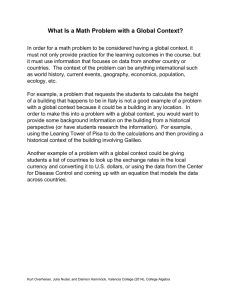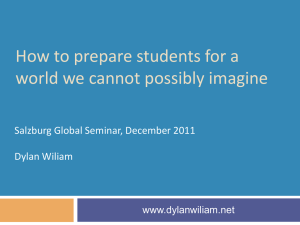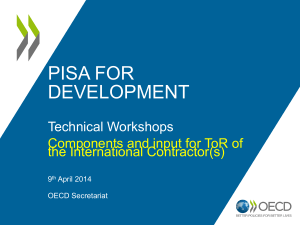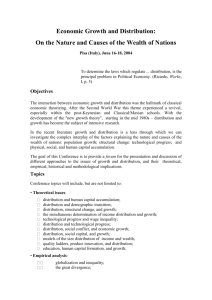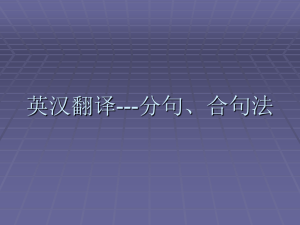From Pisa to Santander: A Statement on Children’s Growth and Wellbeing
advertisement
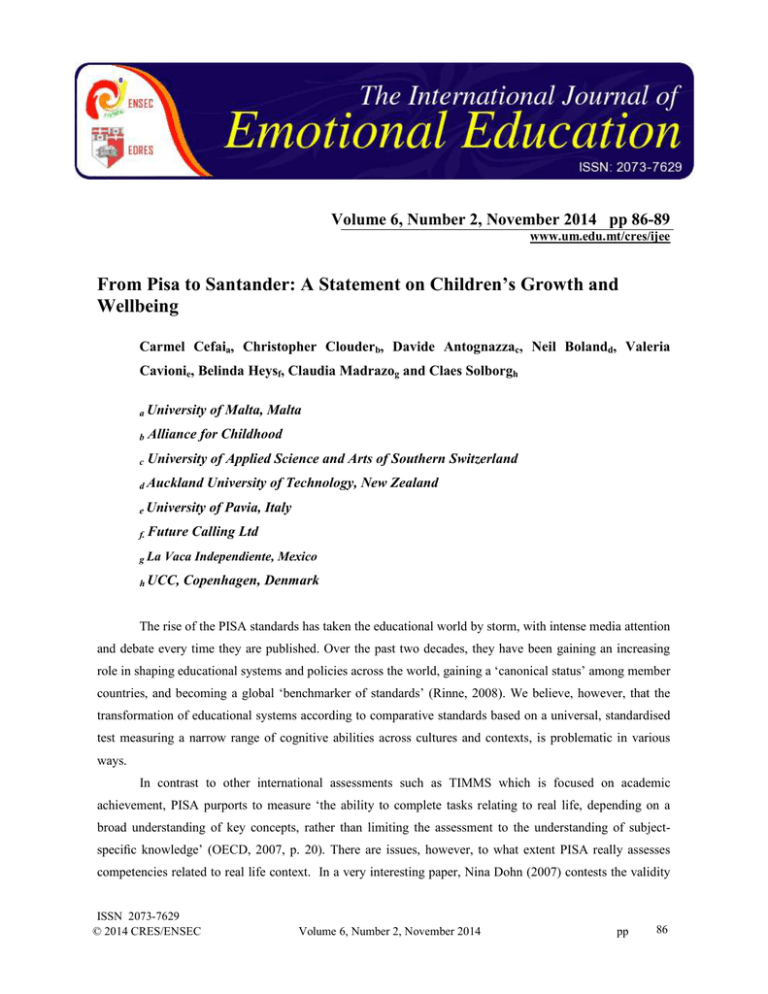
Volume 6, Number 2, November 2014 pp 86-89 www.um.edu.mt/cres/ijee From Pisa to Santander: A Statement on Children’s Growth and Wellbeing Carmel Cefaia, Christopher Clouderb, Davide Antognazzac, Neil Bolandd, Valeria Cavionie, Belinda Heysf, Claudia Madrazog and Claes Solborgh a University of Malta, Malta b Alliance for Childhood c University of Applied Science and Arts of Southern Switzerland d Auckland University of Technology, New Zealand e University of Pavia, Italy f. Future g La Calling Ltd Vaca Independiente, Mexico h UCC, Copenhagen, Denmark The rise of the PISA standards has taken the educational world by storm, with intense media attention and debate every time they are published. Over the past two decades, they have been gaining an increasing role in shaping educational systems and policies across the world, gaining a ‘canonical status’ among member countries, and becoming a global ‘benchmarker of standards’ (Rinne, 2008). We believe, however, that the transformation of educational systems according to comparative standards based on a universal, standardised test measuring a narrow range of cognitive abilities across cultures and contexts, is problematic in various ways. In contrast to other international assessments such as TIMMS which is focused on academic achievement, PISA purports to measure ‘the ability to complete tasks relating to real life, depending on a broad understanding of key concepts, rather than limiting the assessment to the understanding of subjectspecific knowledge’ (OECD, 2007, p. 20). There are issues, however, to what extent PISA really assesses competencies related to real life context. In a very interesting paper, Nina Dohn (2007) contests the validity ISSN 2073-7629 © 2014 CRES/ENSEC Volume 6, Number 2, November 2014 pp 86 of the assessment, arguing that rather than an assessment of the knowledge and skills for life, PISA is only a measure of knowledge and skills in assessment situations. The methodology chosen does not make it possible to investigate knowledge and skills for life; instead PISA assesses students’ competence in one ‘real life’ situation, which is the PISA test situation. There are further issues related to the validity and reliability of the results, such as the inflation of results through cramming and rote learning of narrow and simplistic indicators in the Pacific Rim countries (Tucker, 2011), and ‘gaming’ of results through selection and exclusion of students in the west (Ravich, 2010). A more fundamental and epistemological issue, however, is PISA’s narrow view of what education is about, namely a reductionist, measurable, economic project (Meyers, 2013). We believe in a broader agenda of education, one integrating the person’s physical, social, emotional, artistic and spiritual development. Besides preparing the individual for the world of work, education strives to promote such areas as selfdetermination and autonomy, growth and self-actualisation, and active and meaningful participation and engagement in society. Education is preparing children and young people for the tests of life in the twenty first century, leading to the formation of academically, socially and emotionally literate young people who have the skills and emotional resilience necessary to navigate the uncertain but fast moving present and future (Cefai & Cavioni, 2014; Clouder, 2008; Diamond, 2010; Noddings, 2012; Seligman et al, 2009). Children and young people also need a stress-free, enjoyable and caring learning environment where they can develop such competencies. PISA’s accent on competition, academic pressure and testing may lead to increased stress amongst both school children and staff, and rather than serving as a medium for growth and self-development, education might thus become a health hazard for both children and adults. Such a system is also likely to make learning less meaningful and enjoyable for children and young people, leading to lack of motivation and active engagement in the educational process. We believe that the PISA standards may also pose a threat to diversity and social inclusion, and consequently to social justice and equity. The drive towards the global convergence and standardisation of education, leading to country ranking on the basis of a common single instrument, may lead governments, educational authorities and schools, to strive to increase academic performance by streamlining policies and practices, limiting the flexibility of teachers to engage in culturally responsive, inclusive and humanistic education. The one size fits all, positivistic paradigm may find itself seeping into educational systems, schools and classrooms, leading to ranking and labelling of students, teachers, and schools. This may take place at regional and national levels as well, with regions and countries being compared with each other and ranked into high or low performing without due attention to their particular social and cultural context (see Zhao, 2012). Such a system is also set to lead to increased socio-economic inequality, with rich and poor segregated into separate schools as a result of competition (Pring, 2012). The Santander Declaration We are therefore arguing for a different kind of education than the one emerging from the PISA standards process. We are for a more humanistic, inclusive, democratic, equitable, and holistic education for our children and young people. One which is culturally responsive and addresses the diversity of learners’ ISSN 2073-7629 © 2014 CRES/ENSEC Volume 6, Number 2, November 2014 pp 87 needs. One which puts back the school community, including students, staff and parents, at the centre of the educational process, allowing it to adapt teaching and learning according to its needs and particular context. One which moves away from a market economy type of education to a holistic model addressing the physical, social, emotional, spiritual and artistic development of the learners. One which promotes growth and wellbeing and solidarity and collaboration rather than competition, testing, and stress. This vision of education is captured in the declaration which we drafted together in Santander, Cantabria, Spain in April 2014, and which we believe would help to protect our children and young people from the possible dangers emanating from the culture being propagated by the PISA Standards. The following statement is here referred to as the Santander Declaration. We believe that Every child and young person has the right to a balanced, meaningful, holistic, creative and arts-rich education. In order to advance the above, we commit ourselves to promote the following: 1. That schools and early years settings provide a learning environment where academic, social and emotional education competences are in creative balance; 2. That schools and early years settings operate as learning and caring communities in which all students, teachers and parents have the opportunity to experience sustainability and wellbeing; 3. That educational and learning contexts consciously seek to strengthen students’ connectedness with themselves, others and the environment; 4. That social and emotional education be embedded in all initial teacher education and that practicing teachers and educators can access on-going professional education and support to continuously develop their relational and emotional competences; 5. That schools and early years settings have the autonomy and agency to determine their educational and social agenda according to their own respective cultures and contexts. References Cefai, C. & Cavioni, V. (2014). Social and emotional education in primary school. Integrating theory and research into practice. New York: Springer Publications. Clouder, C. (2008). Introduction. In Fundación Marcelino Botín. Social and emotional education: An international analysis. Santander, Spain: Fundación Botín. Diamond, A. (2010). The evidence base for improving school outcomes by addressing the whole child and by addressing skills and attitudes, not just content. Early Education & Development, 21(5), 780-793. Dohn, N. B. (2007). Knowledge and skills for PISA – Assessing the assessment. Journal of Philosophy of Education, 41(1), 1-16. ISSN 2073-7629 © 2014 CRES/ENSEC Volume 6, Number 2, November 2014 pp 88 Meyers, H. (2013) OECD’s PISA: A Tale of Flaws and Hubris. Teachers College Record. Retrieved on 2nd September 2014 from: http://www.tcrecord.org Noddings, N. (2012). The caring relation in teaching. Oxford Review of Education, 38(6), 771-781. OECD. (2007). PISA 2006 science competencies for tomorrow’s world: Volume 1 analysis. Paris, France: OECD. Pring, R. (2012). Putting persons back into education. Oxford Review of Education, 38(6), 747-760. Ravitch, D. (2010) The Death and Life of the Great American School System: how testing and choice are undermining education. New York: Basic Books Rinne, R. (2008).The growing supranational impacts of the OECD and the EU on national educational policies, and the case of Finland. Policy Futures in Education, 6(6), 665–80. Seligman, M. E., Gillham, J., Reivich, K., Linkins, M., & Ernst, R. (2009). Positive education. Oxford Review of Education, 35(3), 293-311. Tucker, M. (2011) Surpassing Shanghai. An Agenda for American Education Built on the World’s Leading Systems. Cambridge, MA: Harvard Education Press. Zhao, Y. (2012) World Class Learners. Educating Creative and Entrepreneurial Students. Thousand Oaks, CA: Corwin Press. ISSN 2073-7629 © 2014 CRES/ENSEC Volume 6, Number 2, November 2014 pp 89

